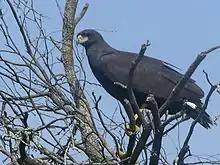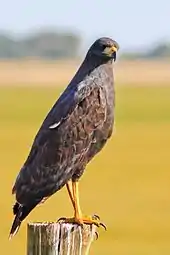Great black hawk
The great black hawk (Buteogallus urubitinga) is a bird of prey in the family Accipitridae, which also includes the eagles, hawks, and Old World vultures.
| Great black hawk | |
|---|---|
 | |
| Scientific classification | |
| Kingdom: | Animalia |
| Phylum: | Chordata |
| Class: | Aves |
| Order: | Accipitriformes |
| Family: | Accipitridae |
| Genus: | Buteogallus |
| Species: | B. urubitinga |
| Binomial name | |
| Buteogallus urubitinga (Gmelin, 1788) | |
| Subspecies[2] | |
| |
 | |
Description
The adult great black hawk is 56 to 64 centimetres (22 to 25 in) long and weighs 1.1 kilograms (2 lb 7 oz). It resembles the common black hawk, but is larger with a different call and tail pattern. It has very broad wings, and is mainly black. The short tail is white with a broad black tip. The bill is black and the legs and cere are yellow.
The sexes are similar, but immature birds are dark brown above with spotting and streaks. Their underparts are buff with dark spots, and the tail has a number of black and dusky bars. The call of great black hawk is a distinctive piping ooo-wheeeeee.
Distribution and habitat
The great black hawk is a resident breeding bird in the tropical New World, from Mexico through Central America to Peru, Tobago and northern Argentina. It is a mainly coastal bird, but also lives in forests and open woodland near water.
A great black hawk was first recorded in the ABA area on South Padre Island, Texas in April, 2018.[3] In August of that year the same individual, based on similarities in what is highly variable immature plumage, resurfaced in Biddeford, Maine.[4] This individual was ranked as the #1 "Craziest Vagrant of 2018" by the ABA.[5]
After disappearing for several months it reappeared in Deering Oaks park in Portland, Maine,[6] where it remained a resident until being rescued during a snow storm on January 20th,[7] and transported to the bird rehab facility Avian Haven. The bird was euthanized on January 31st at Avian Haven because of extensive frostbite which prevented blood from reaching either leg or foot.[8] In January of 2020 it was mounted and is set to be displayed at the Maine State Museum.[9]
Breeding
It builds a large stick nest in a tree, and usually lays one dark-blotched whitish egg.
Diet
The great black hawk feeds mainly on reptiles, other small vertebrates and large insects, often hunted on foot. This species is often seen soaring above woodlands. Along Amazon rivers it has been observed raiding hoatzin nesting colonies looking for eggs and chicks.
References
- BirdLife International (2012). "Buteogallus urubitinga". IUCN Red List of Threatened Species. 2012. Retrieved 26 November 2013.CS1 maint: ref=harv (link)
- Gill F, D Donsker & P Rasmussen (Eds). 2020. IOC World Bird List (v10.2). doi : 10.14344/IOC.ML.10.2.
- Mendenhall, Matt. "Great Black Hawk spotted on South Padre Island, Texas -". BirdWatching. Retrieved 2019-02-01.
- Writer, Deirdre FlemingStaff (2018-08-09). "Birders flock to Biddeford to view hawk that's been seen only once before in the U.S." Press Herald. Retrieved 2019-02-01.
- "The TOP 10: Craziest Vagrants of 2018". ABA Blog. 2019-01-31. Retrieved 2019-02-01.
- Report, Staff (2018-11-29). "Rarely seen hawk appears again, this time at Deering Oaks park in Portland". Press Herald. Retrieved 2019-02-01.
- "Avian Haven". www.facebook.com. Retrieved 2019-02-01.
- "Avian Haven". www.facebook.com. Retrieved 2019-02-01.
- "The Great Black Hawk of Deering Oaks mounted, headed to Maine State Museum". WCSH. Retrieved 2020-03-12.
External links
| Wikimedia Commons has media related to Buteogallus urubitinga. |
| Wikispecies has information related to Buteogallus urubitinga. |

_immature.JPG.webp)

